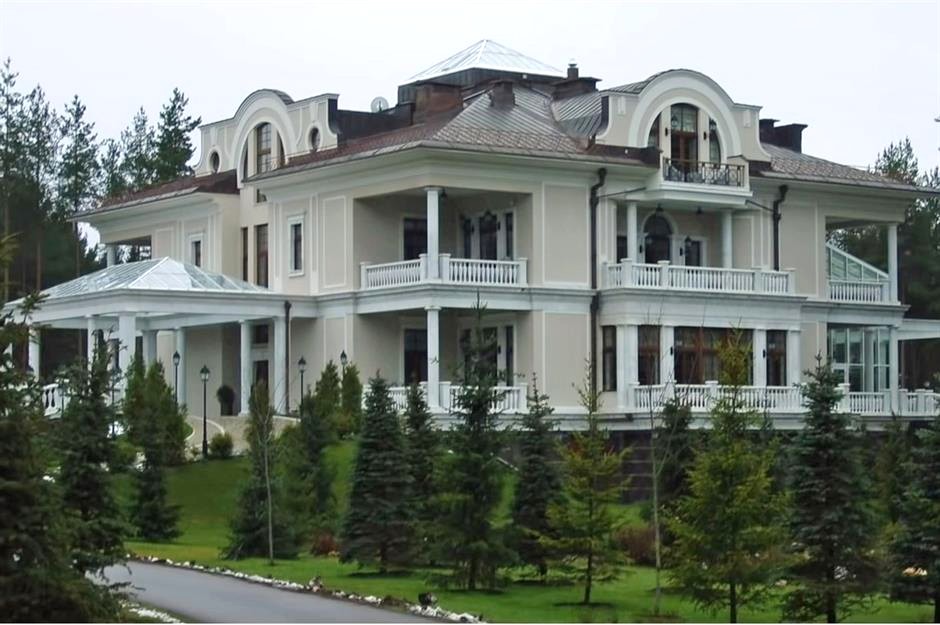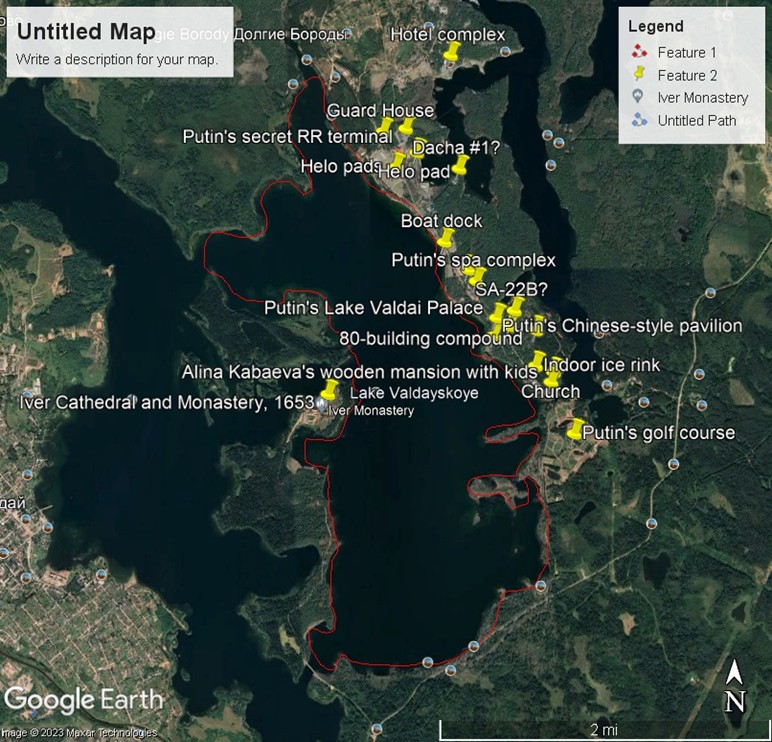“The Pantsir-S1 was designed to provide point, air defense of military, industrial, and administrative installations against aircraft, helicopters, precision munitions, cruise missiles, and UAVs, and to provide additional protection to air defense units against enemy air attacks, employing precision munitions, especially at low to extremely low altitudes.” — Wikipedia, 2025.
“Russia never lost the Cold War, because it never ended… If someone wants to open this Pandora’s box and deal with it, all right, go for it, then.” — Vladimir Putin.
In the vast Russian Federation, President Vladimir Putin has a variety of palaces, compounds, and other hideouts scattered all over the country. But since the war in Ukraine began, and his paranoia has ratcheted up several notches, he’s had to reconsider the safety of several of his country retreats. There’s the opulent, $1.3 billion Gelendzhik Palace on the Black Sea southeast of Dzhankhot, but it’s vulnerable to secret raids from hostile ships at sea, just 12 or more nautical miles offshore.
Putin’s next three options are all dangerously close to Finland, which officially joined the NATO alliance on April 4, 2023. He has an elaborate, “Fisherman’s Hut” retreat on the northern shoreline of Lake Ladoga, about 27 miles from the Finnish border, a ski-resort and racetrack complex at Igora, 62 miles from Finland, and has often stayed at his Villa Sellgren (“Putin’s Dacha”) estate near Vyborg, a mere 17 miles from the border, where Russian military defenses are sparse and questionable, at best. He also has a remote, rustic, timber mansion on the Yenisei River near Krasnoyarsk, Siberia, but it’s too far away (2,100 miles east of Moscow) for easy access.
That leaves Putin’s massive, two-and-a-half mile-long complex spanning the eastern shore of Lake Valdai (or Valdayskoye), in the center of Valdaysky National Park, 214 miles from the Estonian (NATO) border, where he undoubtedly feels much safer. Russians simply call it the “Valdai Residence.” It’s defended by an ultra-long-range battery of SA-20B Gargoyle (S-300PMU-2) surface-to-air missiles at Izhitsy, 11 miles to the northwest, and an SA-21B Growler (S-400 Triumf) battery on-site, just north of Lake Valdai.
In fact, the Gargoyles at Izhitsy, possibly upgraded to SA-21B Growlers by now, may have already tasted first blood. Yevgeny Prigozhin, the former leader of the mercenary, paramilitary Wagner Group, revolted against Putin’s handling of the war effort in Ukraine, and actually led an armed mutiny of troops marching toward Moscow on June 24, 2023.
The mutiny ultimately failed, and Prigozhin died soon afterward in a plane crash on August 23, 2023, when his Embraer Legacy 600 business jet went down just south of Kuzhenkino, Russia, only 43 miles from the SA-20Bs at Izhitsy (a mere 28 miles southeast of Lake Valdai), with a maximum, effective missile range of 121 miles, driving highly credible speculation that Putin had him shot down. Indeed, Western intelligence sources reported that a mid-air explosion (bomb or missile) was the likely cause of the crash, since the left wing was located a full two miles from the crash site.

Over the past 14 months, since mid-2024, the number of air defense systems around Russian leader Vladimir Putin’s small palace in Valdai has increased from two to 12 (possibly 13), as confirmed by the Telegram channel of Radio Liberty, and numerous other reliable sources. The first SA-22B surface-to-air missile system near Putin’s vacation residence was spotted by local residents in January 2023. A year and a half later, in July 2024, journalists discovered the second weapon system.
There are currently no less than 12 short-range, SA-22B Greyhound (Pantsir-S1) gun-and-missile systems around the lake, and Khotilovo Air Base is only 36 miles to the southeast, housing various Su-27P/S Flanker-B, Su-35S Flanker-M, and MiG-31BM/DZ Foxhound-B jet fighters. This was precisely where Vladimir Putin fled during the rampant, nationwide, anti-war protests of September 2022, so he’s escaped to Lake Valdai before, and he continues to use it many times.

In addition, any possible approach routes from NATO territory (meaning Estonia) are guarded by imposing, barrier defenses of SA-21B, SA-22B, and SA-28 Vityaz (“Knight”) missile batteries, the 25th Mechanized Brigade at Luga, the 76th Guards Air Assault Division’s paratroopers and 2nd SpetsNaz (Special Forces) Brigade at Pskov, and the 15th Army Aviation Brigade at Ostrov Air Base, with Ka-52 Alligator, Mi-28N Havoc-B, and Mi-35M1 Hind-E Modified attack helicopters, and various transport helicopters.
These are absolutely formidable defenses, and most of the new SA-22B Greyhounds appear to be mounted on makeshift, steel towers to improve their radar line-of-sight out to 20 miles, and effective firing range of up to 11 miles (or 25 miles for the Pantsir-S2) for each of the dozen 57E6M Greyhound missiles per eight-wheeled, launch vehicle, which also mounts a pair of twin-barrel, 2A38M 30mm cannon, with an engagement range out to 2.5 miles.


In addition to this deadly air defense network, the Valdai Residence, an extensive complex of at least 80 buildings, is defended on the ground by Federal Protective Service (FSO) agents dressed in either civilian attire, black uniforms with black berets, or MultiCam field uniforms, depending upon their duties and circumstances. The FSO has been described by Russian journalists as, “This most mysterious of all Russian special services…is a powerful, multi-purpose, and extremely secretive agency…The FSO as a special service is almost omnipotent.”
These highly capable men are armed with SR-1M Vektor (or Gyurza = “Blunt-nosed viper”) pistols in 9x21mm Gyurza, or newer SR-2 Udav (“Boa”) service handguns, since about 2020, also in the powerful 9x21mm chambering. This is like firing a standard, 9x19mm pistol with very hot, +P+ ammunition at 1,300 feet per second, using 7N42 armor-piercing rounds to penetrate up to 30 layers of Kevlar body armor.
FSO rifles and carbines include AK-105 and AK-12 variants in 5.45x39mm, and some SR-3M Vikhr (“Whirlwind”) short carbines with 6.4-inch barrels in 9x39mm. Sniper rifles have included the Lobaev SVL in .408 CheyTac, the Orsis T-5000M Tochnost (“Precision”) in 7.62x54mmR or .338 Lapua Magnum, and probably the newer Lobaev DXL-4 Sevastopol in .408 CheyTac, replacing the early SVL models.

This imposing ring of air defense guns and missiles around Lake Valdai makes it almost impenetrable to hostile attack. Any ingressing aircraft would have to fly below 30 feet in altitude to avoid the Greyhound missiles, but the 30mm cannon is still lethal at any altitude. Lake Valdai is 388 miles from the Ukrainian border, a considerable distance from enemy forces during wartime.
However, in August 2023, one very special, Ukrainian assault/commando team actually walked an astounding 370 miles on foot, deep into the Russian Federation, in order to destroy a Russian, Tu-22M3 Backfire-C jet-powered, supersonic bomber by an alleged, drone attack on August 19th, and damage two more at Soltsy-2 Air Base, an astounding 414 miles north of Ukraine! Their exceptional, young leader, Colonel Oleh Babiy, age 32, was unfortunately killed in action 11 days later, during an ambush on their way back out of Russia, and was posthumously awarded the Hero of Ukraine medal, equivalent to the prestigious, U.S. Medal of Honor.

This tremendously brave and audacious hero, leading behind-the-lines, commando raider teams, was a senior officer in the elite Main Directorate of Intelligence, or GUR (also known as HUR), the primary military intelligence branch of the Ukrainian armed forces. The ultra-secret organization is comprised of the 10th Special Detachment, eight reconnaissance battalions, the special, all-volunteer, Kraken Regiment, and three National Guard Special Forces detachments (Omega, Vega, and Ares).
As of late 2023, when there was apparently only one SA-22B firing unit present (just 8.5 percent of today’s contingent), it was still technically possibly, although quite risky, to deploy a Ukrainian special operations team at or near Lake Valdai for the purpose of capturing or killing Vladimir Putin during one of his many visits there. I wrote about that possibility at the time. But this very recent and massive SA-22B missile buildup has made a manned approach by aircraft virtually impossible.
What may still be feasible, though, is a GUR commando team arriving on foot from several miles away, and then launching small, portable, armed drones at ultra-low altitude. This would also be extremely difficult and dangerous, but on January 18, 2024, the Ukrainians apparently flew at least one drone over the Valdai complex, setting a bold, wartime precedent.
The GUR also possesses a small aviation detachment with a few U.S.-supplied Mi-17V-5 Hip-H transport helicopters (holds 24 troops), one or two Mi-24V Hind-E gunships, and at least two black-and-blue-painted, UH-60A Black Hawk and Bell 427 special operations helicopters, without FLIR sensors for nighttime operations. Flying any of them near Lake Valdai, however, would be a futile effort.
According to Greg Miller of The Washington Post on October 23, 2023, “Ukrainian spies with deep ties to CIA wage shadow war against Russia…elite teams of Ukrainian operatives…trained, and equipped in close partnership with the CIA…‘capable of operating behind front lines and working as covert groups.’”
Lindsay Dodgson wrote for Business Insider on December 17, 2023, that, “Ukrainian special ops commandos are freelancing sabotage missions in Russia…to carry out sabotage, poisonings, assassinations, and diversions behind enemy lines…‘It’s off the books…They…carry fake papers, no phones, use a compass, a map, and count their steps to orient themselves.’”
Josh Layton added for Metro on January 7, 2024, that, “Ukraine’s special forces are carrying out missions deep behind Russian lines, stalking Russian targets in the dark and operating deep behind enemy lines…Most of the missions which were carried out are still classified and cannot be made public. However…the Ukrainian SOF operate in all operational directions, both on the frontline and behind enemy lines.’”
Most Ukrainians speak their own language, as well as Russian, so these elite commandos already speak fluent Russian, and therefore have no real difficulty traveling incognito behind Russian lines.

Ideally, a GUR raider detachment behind enemy lines should consist of about eight to 12 Russian-speaking, combat-seasoned commandos, wearing unmarked, MultiCam field uniforms, just like most of the Russian SpetsNaz (Special Forces) commando units and special services. This team should include at least one officer, one or two snipers, a team medic, a radio operator, and seven or eight reconnaissance troops.
They should carry captured, suppressed, Russian-made weapons, hopefully including an Orsis T-5000M “Terminator” bolt-action, sniper rifle in .338 Lapua Magnum, a faster-firing, Chukavin SVCh-8.6 semiautomatic, sniper rifle in .338 LM, with suppressor, a Lobaev DXL-4 Sevastopol in .408 CheyTac, or other high-quality, plausibly deniable, foreign weapons.
GUR commandos have worn the standard, 2013 pixelated, woodland-camouflage uniform in the past, but the ever-popular MultiCam pattern has been seen more often lately, and they are also frequently seen in civilian clothing. Some of their weapons include the Glock-17 pistol in 9x19mm, UAR-15 (Zbroyar Z-15, an AR-15 copy) assault rifle, with 10.5-inch, 14.5-inch, or 16-inch barrels, in 5.56x45mm NATO, FN (Belgian-made) SCAR-L carbine in 5.56mm, and the compact, Russian AKS-74U (often suppressed) assault carbine in 5.45x39mm.
Sniper rifles include the Zbroyar Z-10 (or UR-10) in 7.62x51mm NATO with a 20-inch barrel, the older Dragunov SVD in 7.62x54mmR, and the Barrett M107A1 in .50 BMG, since 2018. The Barrett MRAD in .338 Lapua Magnum is also very popular.

Penetrating the vast, new array of SA-21B Growler and SA-22B Greyhound air defense systems surrounding Lake Valdai in order to capture or kill Vladimir Putin may no longer be possible, but if anyone can carry out such an ambitious, covert mission, it’s Ukraine’s battle-hardened GUR intelligence commandos.
These elite warriors continue to execute their embattled nation’s most hazardous and daring, Top-Secret missions, often deep into Russian territory, frequently posing as Russian special operations forces, and striking fear deep inside the enemy’s homeland. There is always a tremendous psychological advantage in taking the war directly to the enemy’s heartland, and that’s where the Ukrainian GUR commandos truly excel.

